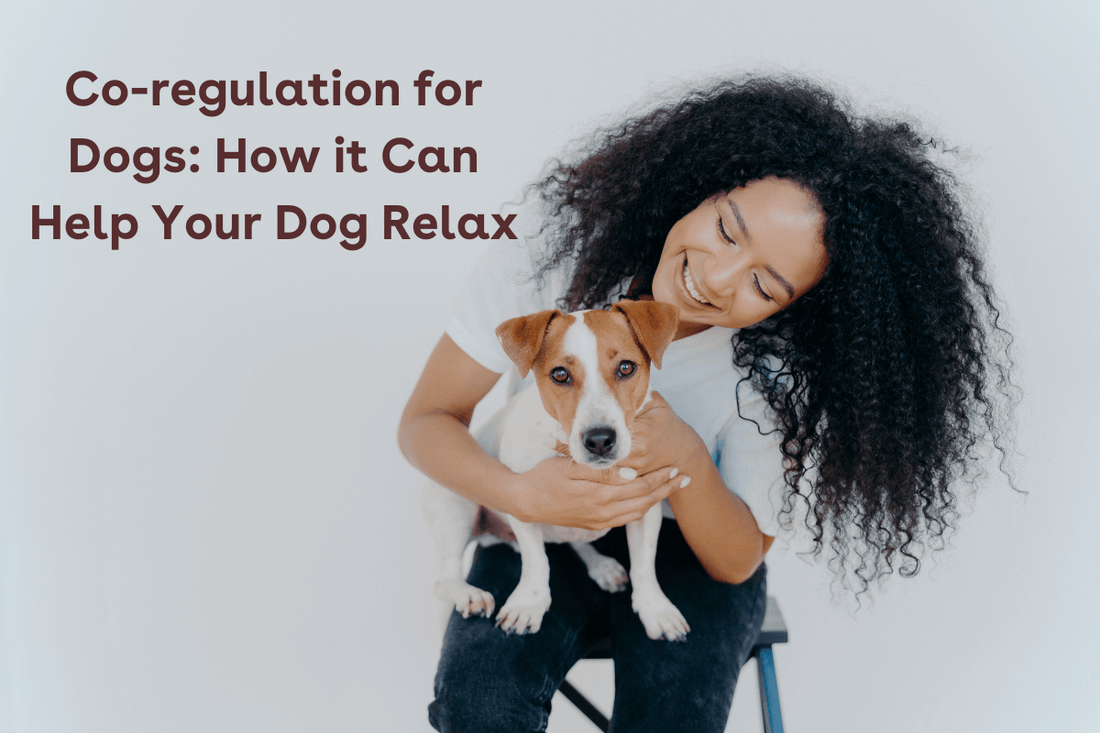You may have heard of co-regulation in terms of a relationship between a parent and child, but what about how co-regulation can affect our relationship with our dogs?
Building a strong bond with your dog goes beyond teaching cues and tricks; creating a harmonious relationship based on trust and understanding can go a long way - especially when addressing behavioral concerns. In this blog post, we’ll explore the concept of co-regulation and self-regulation, and how it can help to relax your dog.
Here’s what we cover:
- Understanding Co-regulation
- Creating a Calm Environment
- Implementing Relaxation Exercises
- Developing Emotional Awareness
- Building Trust Through Positive Reinforcement
- Mindfulness in Training
- Addressing Anxiety and Fear
UNDERSTANDING CO-REGULATION
Co-regulation refers to the mutual influence that individuals have on each other’s emotions and behaviors.
According to the Center for Child and Family Policy, “This term (co-regulation) began as a description of adult support for infants, but it is not used to describe an interactive process of regulatory support that can occur within the context of caring relationships across the lifespan. Co-regulation will look different at different ages as child capacity for self-regulation grows, but remains a critical resource across development.”
In the context of dog training, it involves the dynamic interaction between you and your dog. Instead of relying solely on cues and obedience, co-regulation focuses on establishing a connection that promotes emotional well-being for both you and your dog. Here are a few ways you can improve co-regulation.
CREATING A CALM ENVIRONMENT FOR YOUR DOG

One of the key aspects of co-regulation is the creation of a calm environment. Dogs, like humans, are sensitive to their surroundings. By maintaining an environment with minimal stressors you can positively impact your dog’s emotional state.
Consider factors such as lighting, noise levels, and your dog’s overall comfort to ensure your dog feels at ease.
This goes for your feelings of stress too. If you are attempting to train your dog while stressed or frustrated, you will likely be less successful than if you were in a calm state of mind.
IMPLEMENTING RELAXATION EXERCISES
Incorporating relaxation exercises into your training routine can significantly contribute to co-regulation. A great way to teach your dog how to settle in new, distracting, or stressful situations is with the Relaxation Protocol. This not only helps your dog learn to self-regulate but also improves their ability to have a calm state of mind in times of stress.
Another great way to help your dog relax every day is by providing them opportunities for mental enrichment. Specifically licking, sniffing, and chewing. These behaviors release feel-good hormones like serotonin and dopamine and are naturally relaxing for our dogs.
DEVELOPING EMOTIONAL AWARENESS

Successful co-regulation hinges on your ability to recognize and understand your dog’s emotions. Dogs communicate through body language, vocalization, and facial expressions. Being able to recognize signs of stress in our dogs will help us with our training plans and improve our bond with our dogs by being able to address these feelings promptly. To learn more about dog body language, check out our blog post, here!
BUILDING TRUST WITH YOUR DOG
Reward-based training methods not only motivate your dog but also strengthen the bond between you and your dog. Using training methods focused on punishment or pain can create fear and diminish your dog's ability to self-regulate.
Instead, focus on praising and rewarding desired behaviors using treats and affection. This approach not only boosts your dog’s confidence but also cultivates a sense of security.
MINDFULNESS IN DOG TRAINING
Something I learned early on in my dog training career is to train the dog in front of you.
By focusing on training the dog in their current emotional state and paying attention to subtle body language cues, you will have a more successful training session.
In addition to being mindful of your dog’s feelings, co-regulation involves the parents’ emotions and ability to self-regulate as well.

“The first thing for caregivers such as parents, teachers, coaches, and other mentors to focus on is their own capacity for self-regulation. To co-regulate successfully, caregivers will need to:
- Pay attention to their feelings and reactions during stressful interactions
- Pay attention to their thoughts and beliefs about the behaviors of others
- Use strategies to self-calm and respond effectively and compassionately.”
ADDRESSING ANXIETY AND FEAR IN DOGS
Some dogs may have underlying anxiety or fear issues that impact their behavior. Co-regulation involves addressing these issues with patience and understanding.
Identify the triggers that cause stress for your dog and work on desensitizing them through gradual exposure. Positive reinforcement can help change your dog’s emotional response to these triggers and gradually reduce anxiety.
In terms of dog training, co-regulation is a way to foster a healthy relationship with your dog based on trust and compassion. By managing their environment, understanding you and your dog’s emotions, and using positive reinforcement techniques, you can have a calmer (and happier!) canine companion.









